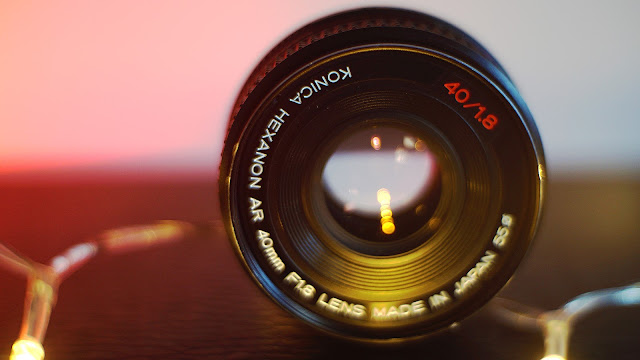Konica Hexanon AR 40mm f1.8 - lens review
There’s a bit of a story behind acquiring this lens. In the summer of 2019 I went to a different flea market, one I had never been before and on a table I saw a camera and a couple lenses. I quickly inspected them and while they seemed in great conditions, but I barely knew the Konica name and had no knowledge on how good, or bad, it could be, so I left it there. Considering that I usually buy almost anything, it was pretty uncharacteristic of me. By the time I got home I was still thinking about that lens, so I looked it up on the internet and realized that at least the 40mm was supposed to be a good lens, and the price was fair too. “Well”, I said to myself, “you lose one, you get one, I’ll find something else next time”. A month later I went back to that flea market and, lo and behold, there it was, still waiting for me, so I bought it, along with some paperwork, a small catalog, the Kenlock 100-300mm, an Autoreflex TC camera, which I will eventually try, and a focal multiplier.
The Konica Hexanon 40mm f1.8 is known for its small size and it is usually referred to as a “pancake” lens. It is in fact only 28mm long when focused to infinity and 32mm when extended, with a 55mm front thread. The body is made of metal, with some plastic elements, most noticeably the front cover with the characteristic red “40/1.8” marking, ant it weighs only 140 grams. Thanks to the catalog in my possession, I can also tell you that it has a 56 degrees taking angle and a 5 groups and 6 elements construction. The iris has six rounded blades and the aperture is clicked and goes from f1.8 to f22, past that it goes into auto exposure mode, as indicated by the green AE marking. At f2.8 and partially at f4 the blades have that “ninja star” shape, but it does not effect boke balls that much. Minimum focusing distance is not bed, at 45cm, and the focusing ring turns a bit less than 180 degrees. Flange distance for Konica Hexanon AR lenses is 40.5mm, so they can be easily adapted to mirrorless cameras, but not on DSLRs.
Even wide open this lens
is sharp, more than I thought, and it produces a very distinctive dreamy,
almost glowing background that I quite enjoy, but it does have some blooming. Stop
it down and it gets even sharper, without any barrel distortion.
No piece of gear comes
without flaws and this lens is no different. It does have some chromatic
aberration, especially wide open, and it does flare and glare a little bit. Some
might see these as flaws, some might consider it more cinematic, to each his
own.
In my experience this
lens has showed me two different looks, two different souls: wide open it gets
just a little bit softer, kind of glowy and dreamy and, in some ways, cinematic,
while stopped down it gets really sharp and gives a more modern look. We could
almost say it bridges between a vintage, quirky and cinematic lens and a modern,
sharp, precise one. Plus, it really is a small lens, so much so that even with
the adapter on it still is the smallest among the vintage lenses I own, making
it a perfect choice for day to day use.
I've gotta say that I'm
pretty happy that I didn't miss this lens the second time around because it
left a really positive impression on me and it does have a very distinctive
look, both among the lenses I own and vintage lenses in general. Anyway, I like
this lens and it will probably find a place in my workflow.
So, if you happen to
stumble upon one of these consider buying it, but don’t overpay for it: 40
euros is a fair price for one in perfect conditions.
As always, if you have any questions, feel free to ask in the comments and don’t forget to check the full video for all the samples.



Comments
Post a Comment